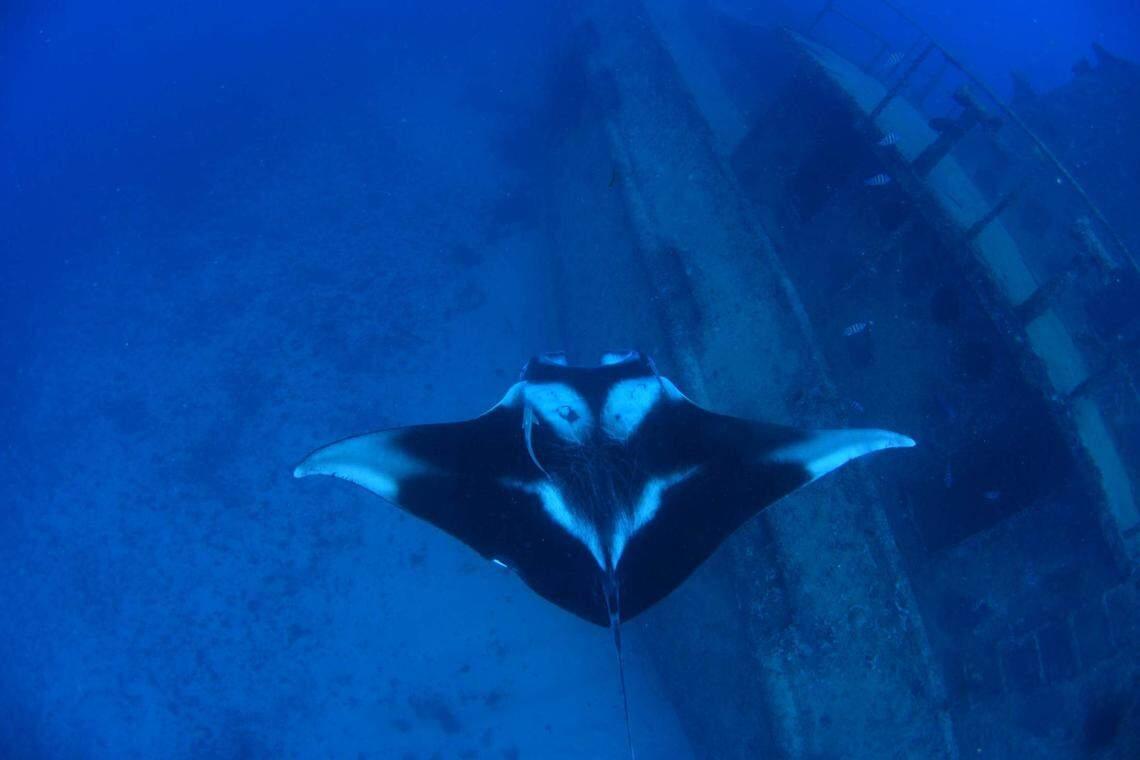A Mobula yarae, or Atlantic manta ray, with more vivid colors.
Rawany Porfilho, Dolphin Eye Aquáticos
For more than 15 years, Marine Megafauna Foundation co-founder Dr. Andrea Marshall suspected that one of the animals she was seeing in the Atlantic Ocean was something new. It looked similar to known manta species… but, something was different. Thanks to a combination of physical examinations and genetic analysis, that hunch has paid off, representing the culmination of a scientific journey that began in 2009. Back then, Marshall revolutionized manta ray science by splitting what was thought to be one manta ray species into two distinct species. Now, she and a collaborative team have done it again: meet Mobula yarae, a newly described manta ray species that calls the Western Atlantic home (and is named after Yara, a water spirit from Indigenous Brazilian mythology).
“In 2009, it was one of the largest species discoveries of the last 50 years. It was huge for me as an early career scientist and such a privilege to go through every step of the process. Did I ever expect to do something like that again? Hell no. Not a chance. So it was one of the shocks of my life to jump into the warm waters off the Yucatán in Mexico about a year later and come face to face with what I instantly knew was a third species of manta ray,” Marshall recounted in a past Facebook post provided in a press release statement by MMF. “It had been pretty shocking to everyone that there were two species of manta ray and suddenly I had to argue that there were three. To be honest, I was not sure if anyone would believe me. But there was never a doubt in my mind. That confidence came from the fact that it had taken me six years to differentiate the first two species and I knew them inside out at this stage. This manta didn’t look like either of them.”
But while this is a win for science, the news comes with a familiar caveat: the species is already showing signs of being in trouble.
The publication is a mixture of bittersweet success; while the team must be elated to finally have the work out in the open, Marshall had been working with international collaborators to publish this formal description of Mobula yarae when she suffered a severe brain aneurysm and stroke in early 2024, following which she remains on long-term medical leave. That left the work uncompleted until an international research team led by Brazilian researcher Nayara Bucair from the University of São Paulo, with MMF’s Jessica Pate, carried forward the collaboration and provided Andrea’s data and observations. This work goes back over a decade ago, when between 2009 and 2010, Marshall spotted an unusual manta ray in Brazilian footage captured by Brazilian researcher Ana Paula, who had spent years documenting these majestic animals. Marshall was convinced it didn’t match known species. That moment, paired with years of persistent photo IDs, fieldwork, and the first-ever necropsy in Brazil, revealed that a species with a wider Atlantic range than previously thought. But it wasn’t until 2017, when a juvenile manta washed up in Florida and a young Pate answered the call to retrieve it, that the missing piece of the puzzle came together. Guided remotely by Marshall, Pate secured and preserved the specimen, which would become the holotype for the newly described Mobula yarae. From freezer reshuffling to roadside inspections mid-journey to the Smithsonian, the manta’s journey to formal recognition was as dramatic as the discovery itself.
The research, recently published in Environmental Biology of Fishes, describes Mobula yarae using detailed data from rays found across Atlantic waters. The team focused on two main lines of evidence: what the animal looks like on the outside and what its genes reveal. Physically, Mobula yarae can be told apart from its close relatives like Mobula birostris and Mobula alfredi by several features. For one thing, their skin is covered in star-shaped dermal denticles that doesn’t split at the tips; while this detail is invisible to the naked eye, it’s important for identification. This new ray also has a distinct V-shaped patch behind its gills on the dorsal side, a unique set of color patterns on its belly, and a residual tail spine set in a caudal bulb. Another tell-tale sign it was a different species is that it has between 9 and 13 rows of teeth, unlike other mantas that have more. Genetically, Mobula yarae also stands out. Scientists analyzed nearly complete mitochondrial genomes and nuclear DNA from various specimens and while they are closely related to M. birostris and M. alfredi, the team found their evolutionary tree clearly placed M. yarae as its own distinct lineage. What makes Mobula yarae especially fascinating is how new it is, evolutionarily speaking, with the researchers believing it is still diverging from the giant manta (making this find a rare opportunity to watch a species take shape in real time). “It’s a classic case where genetic analysis was needed to confirm what careful morphological observation suggested,” explained Pate in the press release. “The differences are consistent once you know what to look for, but they’re subtle enough that definitive identification requires expertise.”
A Mobula yarae, or Atlantic manta ray, seen near some scuba divers.
Andre Viana, Barracuda Imagens
Put all together, it was enough evidence for the global team to officially name and describe the species. But the question on some lips might be, “Why did it take so long to identify Mobula yarae as its own species?” Part of the reason is that manta rays are large, mobile animals and that makes it difficult to study them in detail. While they are big animals, the ocean is bigger, so finding them and having the opportunity to study them at length is difficult. Add to the mix that they don’t stay in one place for long, tend to roam large swaths of ocean, and also look pretty similar at first glance, and without close inspection and genetic testing, differences can be hard to notice. It wasn’t until the multiple lines of evidence aligned that the researchers were confident enough to make the call.
So far, it has only been spotted in Atlantic waters, often near oceanic islands, archipelagos, and sometimes along coastal and estuarine zones. But these are all areas increasingly under stress with man-made pollution, coastal development, habitat destruction, and intense boat traffic, all threatening the ecosystems these rays depend on. And there’s another problem, too — Mobula yarae has already been caught as bycatch in fisheries operating in this region. Sometimes they are discarded, sometimes shared or sold. Sadly, like its close relatives, this ray is vulnerable to human activity. The sad thing is that this is true even before most people knew it existed. Manta and devil rays are already considered some of the most threatened fish in the ocean because they grow slowly, reproduce infrequently, and depend on specific habitats. Once populations begin to decline, they often struggle to bounce back, making early recognition and protection of new species like Mobula yarae especially important. Knowing it exists is only the first step. Keeping it around? That will take more work.
Now that Mobula yarae has a name (and that name has been broadcast around the world by multiple outlets), it has a better chance at being recognized in conservation policies since official species descriptions are often a pre-requisite for legal protection. This can now inform fishing regulations, protected area planning, and international trade restrictions. But it will only happen if the science reaches decision-makers and if those decision-makers are willing to act. We’ve added one more ray to the tree of life, but whether it remains part of our living oceans will depend on what we do next.









